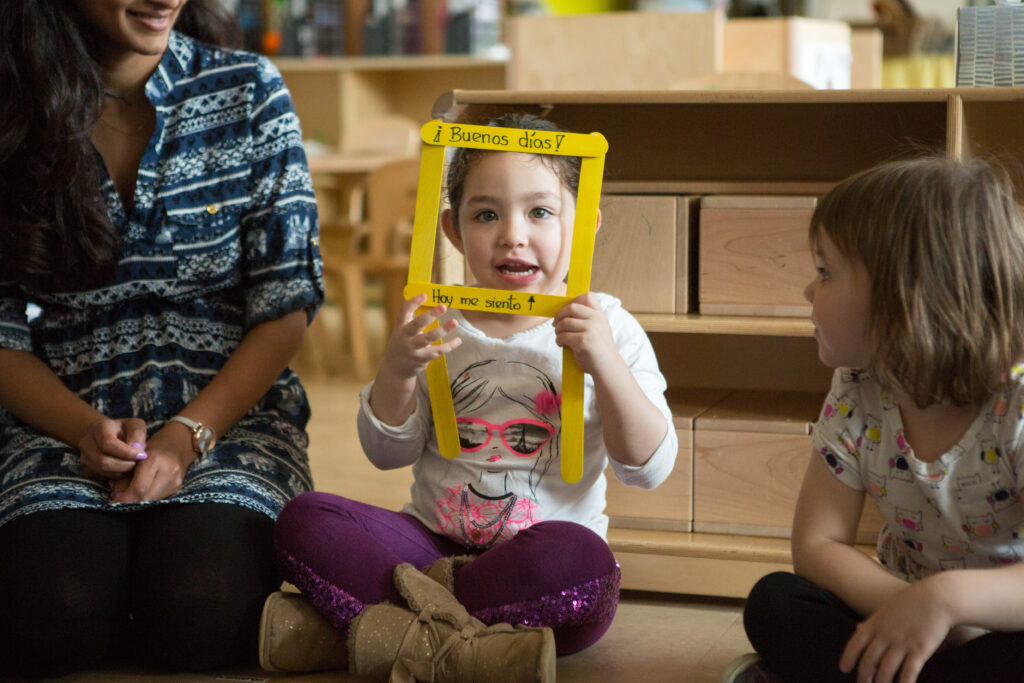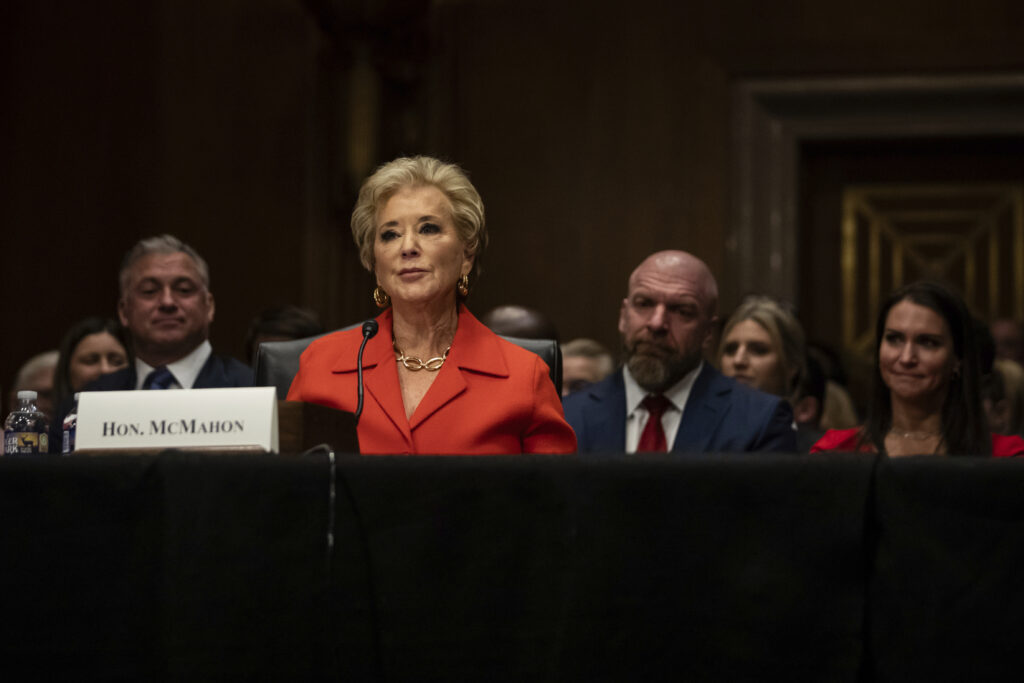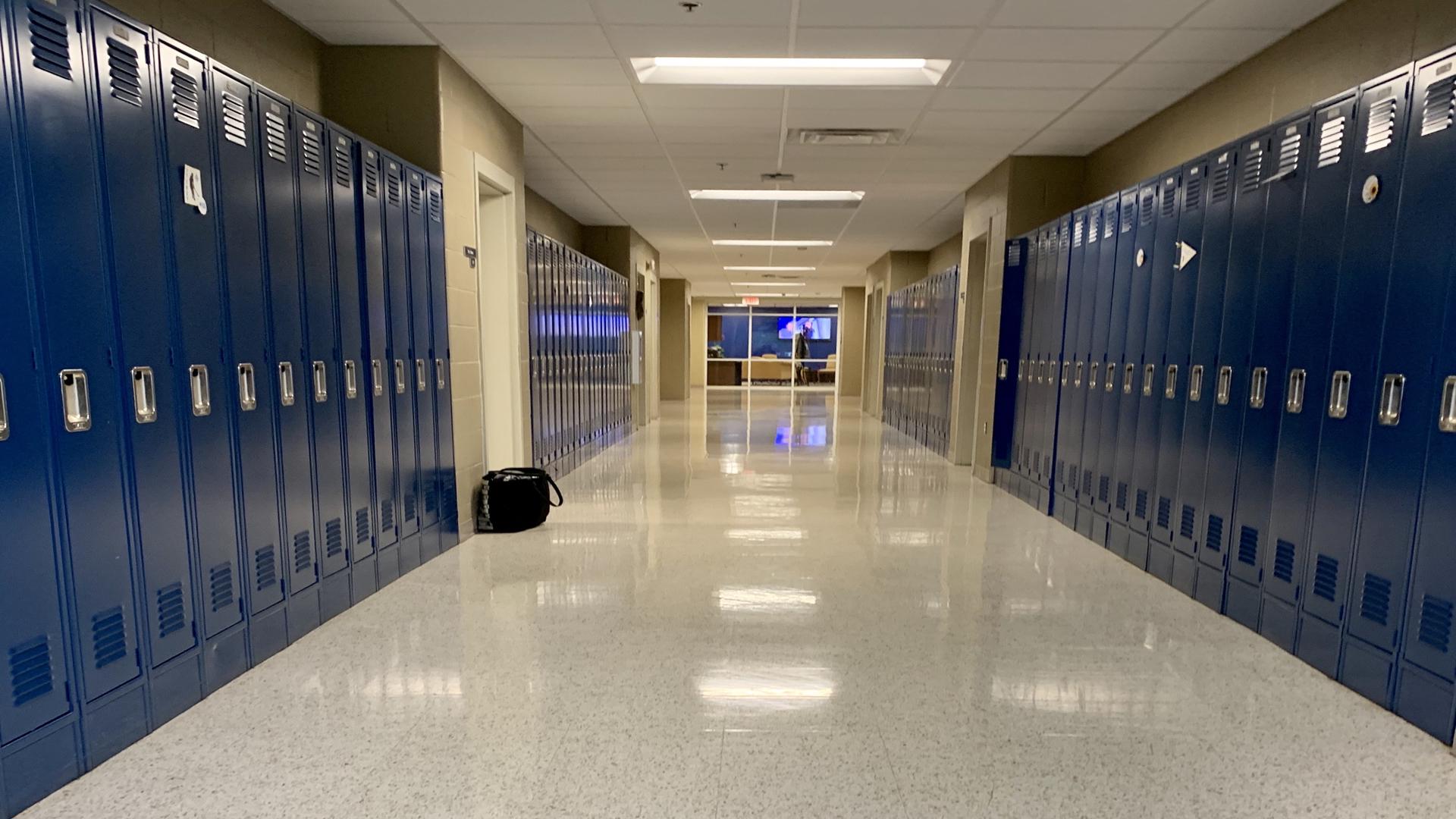
Credit: Allison Shelley for American Education
Este artículo está disponible en Español. Léelo en español.
The pint-sized pupils in Paula Merrigan’s transitional kindergarten, or TK, class often call her mom, or sometimes even grandma. One reason there’s such a strong teacher-student bond boils down to warmth. Merrigan makes sure all the children are greeted with a big smile when they enter the classroom in the morning, she works with every single one of them one-on-one at some point during the day, and she is generous with praise, hugs and affection.
“When a small child tells you they love you, say it back to them!” said the veteran Castro Valley Unified teacher. “They need to know you care. Imagine telling someone, “I love you,” and all you hear back is, “Thank you,” or “OK.” How would that make you feel versus being told, “I love you, too?” If you don’t want to be that specific, you can also say, “I love all of you too.”
Merrigan knows that caring is just as important as the curriculum when it comes to small children. Unless they feel nurtured, they may well struggle to learn.

“It is so important for every child to feel that their teacher truly cares about them, that school is always a safe place to be,” said Merrigan, who also serves on the National Education Association’s (NEA) board of directors for California. “If they don’t make that connection with their teacher, it can impact their learning. When they know you truly care about them, they want to do their best for you, because they are seeking your approval. If they think you don’t care, they don’t care.”
That’s one reason why some little children hate going to school. Consider the case of a first grade boy who had a tantrum when a teacher threw his artwork away. Or a kindergartner who cried when a teacher scolded her for starting her math worksheet too early. Adults may have different criteria for an academic environment, but for small children, friendliness is often the bottom line.
“It’s really just little things like these that make a big difference to a child,” said Merrigan. “When you take them to the office, for whatever reason, they need to know it’s a safe space as well. The cafeteria needs to be welcoming when they are going to get food. Often, young children are just looking for a friendly smile to make them feel better when at school.”
Merrigan also takes pain to listen to the children. She lets them tell her their stories, and she learns where their interests lie so she can engage them more deeply.
“When you learn about certain things they like and tie that into your curriculum, they love it,” she said. “Not that you’re creating a new curriculum. Maybe you’re just recognizing that the children told you they really like dinosaurs so when you’re teaching the letter ‘D,’ you create a dinosaur art project to go with it.”
Separation anxiety hits many youngsters hard as they struggle to let go of their caregiver’s hand when entering the kindergarten classroom. Sometimes it’s the first time they’ll be away from home for a whole day. That stress can feel like a huge chasm for families to cross.
How the child feels at the beginning of their schooling can set the tone for the rest of their academic life, experts say. That’s why the emotional component of early education can not be overlooked.
“This is so important for little ones because this is often the first time that young children are experiencing formal education,” said Hedy Chang, executive director of Attendance Works, a nonprofit that works to boost student attendance. “It may be one of the first times that they are in the care of someone who is not their parent or another adult family member. They are learning how to learn, make friends, overcome conflicts, and thrive outside their home. … What happens during this time can help lay the foundation for social and academic success.”
Mónica Zegers said her daughter Elena had jitters about starting a new school in the middle of the year. Luckily, the teacher had students write little welcome notes to her before she arrived. It was a small gesture that made a magical difference to the third grader. She now keeps the jar of notes in her desk so she can reread them at her leisure.
“This was a wonderful act of kindness that should be celebrated,” said Zegers, a Concord mother of two and a postdoctoral scholar at the UCSF Dyslexia Center. “Many teachers now are overwhelmed, and they don’t have the cognitive bandwidth to really address these social-emotional needs.”
Creating an atmosphere of kindness and generosity is fundamental to learning in the early grades, experts say. That’s why many believe creating a nurturing environment may be key to healing the rifts between many families and schools that grew during the pandemic. Even one caring adult on campus, whether it’s a teacher, a coach or a music teacher, can make the difference between a child who wants to go to school and one who dreads it.

“I’m not sure there is anything as important for young children than feeling comfortable with the teacher,” said Deborah Stipek, an expert in early childhood education at Stanford University. “There is a lot of research on the importance of teacher sensitivity to young children and the relationship between teacher and child. And there is evidence that mental health and behavioral problems have risen since Covid, and the teacher’s sensitivity is all the more important now.”
Amid the youth mental health crisis, it’s more important than ever to make sure children feel a sense of belonging on campus, experts say. The emotional connection between adult and child can be the reason children feel motivated to overcome obstacles, from social anxiety to coping with a playground bully at school.
“What are the little teeny steps that you can provide so people feel comfortable?” said Mary Jane Burke, who served 28 years as Marin County’s superintendent of schools and serves on the EdSource board of directors. “If you are in a great classroom, you can see it in everything that they do. It’s there in the way they greet the children in the morning. I’m huge on relationships; those are the things that I think buoy us in hard times. It can just make such a difference in how you feel.”
Despite its significance to student achievement, not all teacher preparation programs cover how to meet emotional needs as comprehensively as they should, experts say.
“Teacher prep programs vary hugely in how much and how well they address social-emotional issues,” said Stipek, who helped develop the new PreK-3 credential.
Merrigan, for one, will never forget the year her son Andrew had a teacher who didn’t seem to prioritize emotional validation. It was hard on both of them.
“He was a rule follower, and he just wanted to please his teacher,” she remembers. “The constant look of defeat on his little face when he got home from school was heartbreaking. I don’t ever want a child to feel that way.”
Bonding might even be a secret weapon in the battle against chronic absenteeism, which has skyrocketed in the wake of the pandemic, experts suggest. USC researchers found that students of all ages who miss an excessive amount of school often suffer from mental and emotional issues. They may need to feel nurtured, experts say.
“To the degree that parents keep kids home from school because the kids say they don’t want to go,” said Stipek, “children’s relationship with the teacher should be an important factor.”
Merrigan, who herself remembers faking being sick a few times as a child, couldn’t agree more.
“When it comes to truancy, sometimes a child will fake being sick because they just want to take a day off to spend with family,” Merrigan said. “I’ve found most young children want to be in school; they thrive off the consistent expectations for them. Of course, that’s in a school where children know their teachers and staff truly care about them.”





